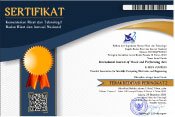(2) Hasbi Hasbi
*corresponding author
AbstractThe illustration process in visual communication design plays a critical role in supporting product development; however, there remains a lack of systematic and empirical studies that examine its practical stages within the design research context, particularly in the field of storybook illustration. This study aims to identify and describe the stages of the illustration process specifically applied in the development of storybook products. A qualitative descriptive case study approach was used, with data collected through literature review, in-depth interviews with four professional illustrators, and document analysis. The data were analyzed using content analysis techniques to extract patterns of practice and define the illustration workflow. The findings reveal an integrated, eleven-stage illustration process that includes narrative exploration, concept development, sketching, refinement, visual enhancement, layout, validation, and final presentation. This process is shown to be iterative, reflective, and context-sensitive, rather than strictly linear. The study contributes a structured conceptual model of the illustration process in design practice, providing theoretical insights and a practical reference for researchers, educators, and practitioners in visual communication design.
KeywordsIllustration Process; Visual Communication Design; Storybook Design; Creative Workflow; Qualitative Research
|
DOIhttps://doi.org/10.31763/viperarts.v7i1.1673 |
Article metrics10.31763/viperarts.v7i1.1673 Abstract views : 160 |
Cite |
References
[1] M. Günay, “Design in Visual Communication,†Art and Design Review, vol. 9, no. 2, Art. no. 2, Apr. 2021, doi: 10.4236/adr.2021.92010.
[2] Y. Wang, “Illustration Art Based on Visual Communication in Digital Context,†Mobile Information Systems, vol. 2022, no. 1, p. 7364003, 2022, doi: 10.1155/2022/7364003.
[3] P. B. Meggs and A. W. Purvis, Meggs’ history of graphic design. John Wiley & Sons, 2016.
[4] F. Huang, E. Schoop, D. Ha, J. Nichols, and J. Canny, “Sketch-Based Creativity Support Tools Using Deep Learning,†in Artificial Intelligence for Human Computer Interaction: A Modern Approach, Y. Li and O. Hilliges, Eds., in Human–Computer Interaction Series. , Cham: Springer International Publishing, 2021, pp. 379–415. doi: 10.1007/978-3-030-82681-9_12.
[5] D. Huang et al., “A survey for graphic design intelligence,†arXiv preprint arXiv:2309.01371, 2023.
[6] N. Hoque, Z. Ara, S. A. Khan, F. Chevalier, and N. Elmqvist, “Characterizing Creativity in Visualization Design,†Apr. 03, 2025, arXiv: arXiv:2504.02204. doi: 10.48550/arXiv.2504.02204.
[7] D. Norman, “The Design of Everyday Things; Revised & Expanded Edition; Basic Book: New York, NY, USA, 2013.
[8] N. Cross, Design thinking: Understanding how designers think and work. Bloomsbury Publishing, 2023.
[9] T. M. Amabile, “The social psychology of creativity: A componential conceptualization.,†Journal of personality and social psychology, vol. 45, no. 2, p. 357, 1983.
[10] A. Loomis, “Successful Drawing,†(No Title), 2012,
[11] R. K. Yin, Case study research and applications: Design and methods. Sage publications, 2017.
[12] V. Braun and V. and Clarke, “Using thematic analysis in psychology,†Qualitative Research in Psychology, vol. 3, no. 2, pp. 77–101, Jan. 2006, doi: 10.1191/1478088706qp063oa.
[13] W. Lidwell, K. Holden, and J. Butler, Universal principles of design, revised and updated: 125 ways to enhance usability, influence perception, increase appeal, make better design decisions, and teach through design. Rockport Pub, 2010. Accessed: Jun. 05, 2025.
[14] M. Misrad, “Diskusi tentang Komik dan Perkembangannya di Studio Makko Mikki Comic Lab.,†2021.
[15] M. Salisbury, Illustrating children’s books: Creating pictures for publication. Bloomsbury Publishing, 2018.
[16] T. Groensteen, The system of comics. Univ. Press of Mississippi, 2007. Accessed: Jun. 13, 2025.
[17] R. Barthes, “Image, Music, Text. New York: Hill and Wang,†English Translation by Stephen Heath, 1977.
[18] Y. A. L. Hermanto, “Visual storytelling in folklore children book illustration,†Asian Journal of Research in Education and Social Sciences, vol. 1, no. 1, pp. 62–70, 2019.
[19] S. Salam, “Seni Ilustrasi: Esensi-Sang Iluslator-Lintasan-Penilaian.†Badan Penerbit UNM, 2017. Accessed: May 16, 2025.
[20] G. Wallas, The art of thought. Harcourt, Brace, 1926.
[21] L. Zeegen, “The fundamentals of illustration,†2020.
[22] M. Kneece, The art of comic book writing: The definitive guide to outlining, scripting, and pitching Your sequential art stories. Watson-Guptill, 2015.
[23] N. Thompson, Style Me Vintage: Step-by-step Retro Look Book: Clothes, Hair, Make-up. Rizzoli Publications, 2012.
[24] S. McCloud, “Making comics: Storytelling secrets of comics, manga and graphic novels,†2006, Accessed: Jun. 13, 2025.
[25] C. Attebery, The Complete Guide to Perspective Drawing: From One-point to Six-point. Routledge, 2018.
[26] H. Borgman, The illustrator’s Guide to pen and pencil Drawing Techniques. New York: Watson-Guptill Publications, 1989.
[27] P. Parr, Sketching for animation: developing ideas, characters and layouts in your sketchbook, vol. 65. Bloomsbury Publishing, 2016.
[28] J. Gurney, Color and light: A guide for the realist painter, vol. 2. Andrews McMeel Publishing, 2010.
[29] “How to Retouch Skin in Portraits Using Frequency Separation | Envato Tuts+.†Accessed: Jun. 13, 2025.
[30] “Art Evaluation: How to Appreciate Art, Judge a Painting.â€
[31] “The Project Gutenberg e-Book of Histoire de la Monarchie de Juillet (7/7); Author: Paul Thureau-Dangin.†Accessed: Jun. 13, 2025.
Refbacks
- There are currently no refbacks.
Copyright (c) 2025 Irfan Arifin, Hasbi Hasbi

This work is licensed under a Creative Commons Attribution-ShareAlike 4.0 International License.
___________________________________________________________
International Journal of Visual and Performing Arts
ISSN 2684-9259
Published by Association for Scientific Computing Electronics and Engineering (ASCEE)
W: http://pubs2.ascee.org/index.php/viperarts
E: sularso@ascee.org
Organized by:
 This work is licensed under a Creative Commons Attribution-ShareAlike 4.0
This work is licensed under a Creative Commons Attribution-ShareAlike 4.0
























